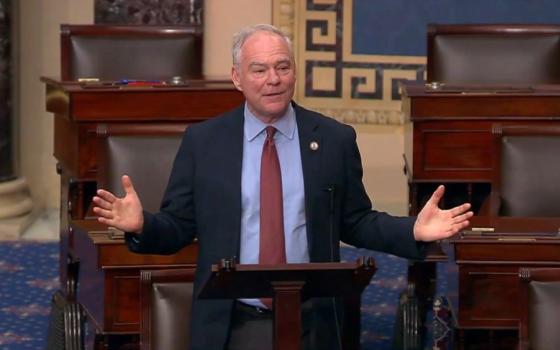
(Unsplash/Bruno Justo Pego)
A bird or a flame. Traditionally, these are the most common images used as metaphors for the Holy Spirit.
The ornithological metaphor is usually traced back to Luke 3:22 when, at Jesus' baptism by John in the Jordan, we are told that "the holy Spirit descended upon him in bodily form like a dove." The latter, more pyrotechnic metaphor is traced to Luke's New Testament sequel, the Acts of the Apostles, and its account of Pentecost. Along with a "strong driving wind," we are told that the apostles were in a locked room when "there appeared to them tongues as of fire, which parted and came to rest on each one of them" (Acts 2:3).
And with these two biblical metaphors was born a practice of depicting the Spirit in these ways within a range of artforms, from confirmation candidates making posters and banners adorned with white doves and floating flames of fire to the famous stained-glass representation of a dove behind the sanctuary in St. Peter's Basilica in Rome.
Despite the apparent hegemony of birds and flames, a wide range of metaphors have been used for the Holy Spirit over the Christian centuries. Since there is no doctrinal claim about how exactly the Spirit is to be depicted, Christians have broad leeway in drawing on experience and imagery to assist them in attending to, thinking about and praying to the Holy Spirit.
This range is reflected in the various metaphors used by some of Christianity's most famous saints and mystics. In her excellent study, Holy Power, Holy Presence: Rediscovering Medieval Metaphors for the Holy Spirit, historical theologian Elizabeth Dreyer surveys some of the medieval classics.
For example, we are reminded of St. Bernard of Clairvaux's deeply incarnate and physical metaphor of the Holy Spirit as kiss; St. Bonaventure's description of the Spirit as flowing water, as transformer of the affections and divine abundance; and St. Catherine of Siena's image of the Spirit as mercy and waiter. This second image from Catherine is particularly moving. She envisions the Holy Trinity as "table, food and waiter," in which the Spirit is the one who serves us the Word who is our food — a great eucharistic image.
Advertisement
One of the gifts of Dreyer's study is that it helps open our imaginations and the ways that the Holy Spirit reveals herself to us within our various contexts. One of my favorite metaphors for the Holy Spirit is that of a musician. We find this expressed by the great mystic and composer Hildegard of Bingen. In her "Hymn to the Holy Spirit," she writes:
Praise to you
Spirit of fire!
To you who sound the timbrel
and the lyre.Your music sets our minds
ablaze! The strength of our souls
awaits your coming
in the tent of meeting.
Additionally, in one of her letters to a Benedictine prioress, Hildegard imagines heaven as "a symphony of the Holy Spirit," further capturing the musicality of God's dynamic movement as Spirit.
I love this image. As someone who is admittedly a rather mediocre musician who has played in liturgical settings as an accompanist or member of an ensemble, I have some basic appreciation for the way music functions not only as entertainment but also as prayer.
For those who know how to play an instrument and have the privilege of playing in a band, orchestra or some other group, you also know the feeling of being connected to others in ways that transcend description and that can only be experienced. This is especially true when musicians improvise together.
Yes, there are fundamental frameworks like time, tempo, meter and key that provide a landscape within which exploration and expression can take place, but in such settings there are often no strictly written scores, predetermined melodies or prescribed chords the soloist must pursue during her time improvising against and with the backdrop of the other musicians holding the foundation. Even knowing when one's turn as soloist has begun or ended is itself more often felt than explicitly planned.
One does not have to be a trained or even amateur musician to appreciate the creative power and dynamism of such music performed in groups. You don't need to know music theory or the technical details of musical performance to enjoy and be moved emotionally and spiritually. There is something profound about the depth of connection that is shared among improvising musical performers and the listening audiences that are drawn into the beauty of live music unfolding before and around them.
What bonds the musicians in that preverbal, nonplanned, creative and dynamic experience of divine co-creation? How is something so original yet harmonious possible in real time?
I recall being in a jazz club in Boston with a friend about a decade ago. The performance space was small, with limited seating and proximity to the stage that reinforced the sense of musical intimacy experienced by all of us gathered there. As is often the case in jazz clubs, the trio or quartet (or in some rare cases, larger ensembles) performs a range of classic and original pieces, each of which typically includes time for improvisation.
A few pieces into the performance, during a particularly moving series of instrumental solos, I remember turning to my friend and saying: "This is what the Holy Spirit looks like!"
It was an impromptu response of both appreciation and awe at what this small group of talented musicians was able to make possible. Each instrumentalist was extraordinarily gifted, and yet, the total experience of their musical collaboration exceeded the sum of their parts. It was inspired and inspiring, an experience of transcendence.
As extemporaneous as my comment was, I have come to reflect on its truth for years. Every time I have been to a jazz club, whether in Boston or Chicago or Indianapolis, that same exclamation inevitably comes to mind. What bonds the musicians in that preverbal, nonplanned, creative and dynamic experience of divine co-creation? How is something so original yet harmonious possible in real time? Indeed, it is the Holy Spirit.
When I think of the Holy Spirit, I think of that invisible connection between improvising musicians, which I have experienced firsthand over the years as a pianist and percussionist, but also experienced as an audience member witnessing the birth of an original moment of musical creation that cannot be predicted and is not individually controlled.
This is how the Spirit works. Moving unpredictably, creatively, forcefully, the Holy Spirit is indeed the "giver of life," but she is also the one who, as Lumen Gentium reminds us, makes possible the fact that "all the faithful, scattered though they be throughout the world, are in communion with each other."
The communion that the Spirit makes possible is often hard to wrap one's head around. Like the vagueness typically associated with the Holy Spirit that has resulted in such limited (and limiting) metaphors like birds and fire, that we are all united to one another and Christ through baptism and the Spirit is difficult to conceptualize. That is, unless you consider the way jazz musicians are in communion with each other.
As I continue to think about the Holy Spirit as jazz, I find myself reflecting on how difficult it is for some people to accept the practical existence and presence of the Holy Spirit in our lives and world.
To be a good jazz musician, you must be open to where the music and your bandmates take you. You know the framework, but not the details. You cannot control the experience nor predetermine every detail.
And for those who are obsessed with control and security, the idea of God as Spirit, who moves where she wills, is threatening or at least discomfiting. For such folks, the temptation to "Holy Spirit atheism" looms large.
So, the next time you listen to live music or jam with your friends or bandmates, ask yourself what the condition of the possibility for such an experience is in the first place. Perhaps then you might take comfort in remembering God's creative presence among you and within creation. This is the presence of the Holy Spirit as jazz.






